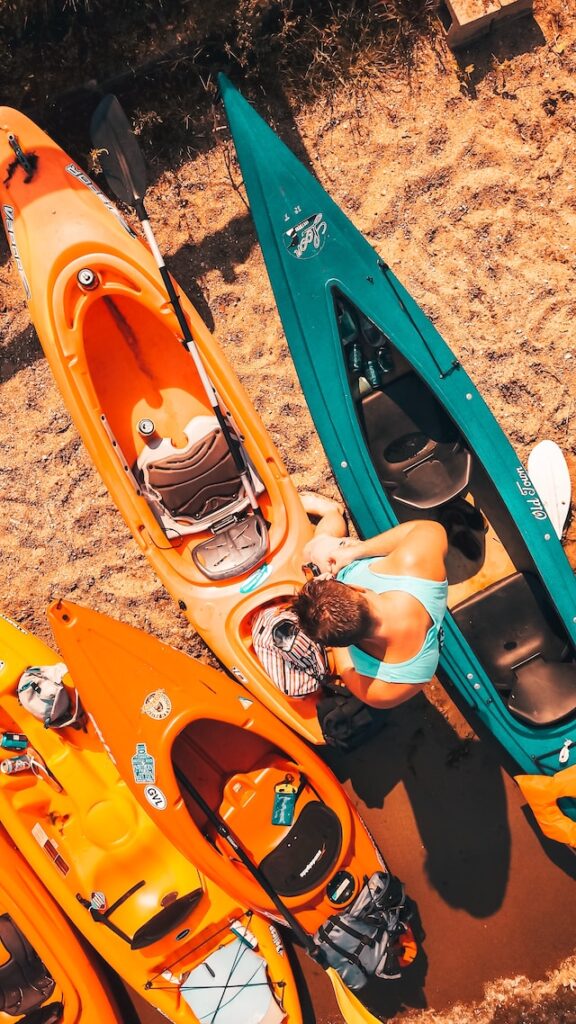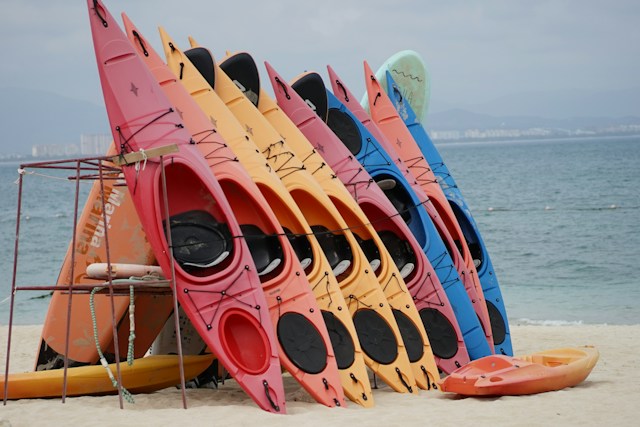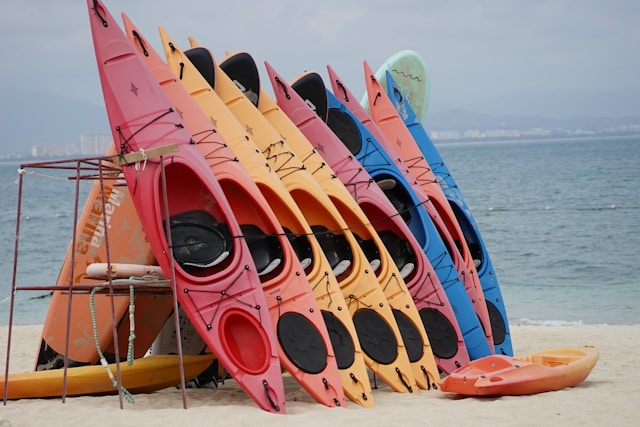How to Clean a Kayak? – The Ultimate Guide
Whether you’re a seasoned paddler or just starting out, maintaining a clean kayak is essential for optimal performance and longevity.
From preventing damage to preserving aesthetics, regular cleaning will keep your kayak in top shape.
This comprehensive guide will provide step-by-step instructions for cleaning both the interior and exterior of your kayak.

No detail will be left out as we walk you through the entire process, ensuring that your kayak remains in pristine condition.
So, grab your cleaning supplies and get ready to learn how to clean a kayak like a pro.
Whether it’s removing debris, tackling stubborn stains, or preventing mold and mildew, this guide has you covered.
Say goodbye to dirt and grime, and hello to a sparkling clean kayak.
- Why Keeping Your Kayak Clean is Essential?
- How to Clean a Kayak?
- How to Clean a Kayak Step by Step
- Cleaning the Inside of Your Kayak
- How to Clean and Protect a Kayak’s Exterior
- Special Care for Different Kayak Materials
- How to Prevent Mold and Mildew in Kayaks
- Kayak Storage Solutions
- Periodic Kayak Maintenance for Longevity
- Conclusion
- Frequently Asked Questions
Why Keeping Your Kayak Clean is Essential?
A clean kayak is not just about aesthetics; it plays a crucial role in ensuring the longevity and performance of your watercraft.
Neglecting proper cleaning and maintenance can lead to accelerated wear and tear, decreased performance, and increased risk of damage.
By regularly cleaning your kayak and removing dirt, debris, and contaminants, you can significantly improve its overall performance and extend its lifespan.
A clean kayak glides through the water more efficiently, allowing you to paddle with ease and precision.
Additionally, maintaining a clean kayak helps preserve its appearance.
Dirt and grime can gradually build up on the surface, dulling its shine and beauty.
By keeping your kayak clean, you can showcase its vibrant colors and sleek design, enhancing your overall paddling experience.
Moreover, cleaning your kayak is essential for safety.
A dirty kayak can harbor bacteria and mold, posing health risks to you and your paddling companions.
By regularly cleaning and disinfecting your kayak, you can create a safe and enjoyable paddling environment.
To enjoy all these benefits, it’s important to include kayak cleaning as part of your regular maintenance routine.
Whether you’re a weekend warrior or a seasoned kayaker, taking the time to clean and maintain your kayak will ensure it performs optimally and lasts for years to come.
How to Clean a Kayak?
Before you begin cleaning your kayak, it’s important to make sure you have all the necessary supplies.
Gathering the right cleaning supplies is essential for a thorough and effective cleaning process.
Cleaning Supplies
To clean your kayak properly, you will need a few essential cleaning products and equipment.
Here’s a checklist of the items you should gather:
- Cleaning agents: Choose a mild detergent or kayak-specific cleaning solution to avoid damaging the kayak’s material.
- Brushes: Have a soft-bristle brush for general cleaning and a scrub brush or sponge for tackling stubborn stains or dirt.
- Sponges and towels: Use sponges to scrub the kayak’s surface and absorb excess water, and have clean towels ready for drying.
- Protective gloves: Wear gloves to protect your hands from cleaning agents and prevent any skin irritation.
- Bucket: Fill a bucket with clean water for rinsing your kayak.
- Hose: If you have access to a hose, it can be helpful for rinsing off cleaning agents and debris.
Cleaning Location
When it comes to cleaning your kayak, choosing the right location is crucial.
Look for a spacious area with good ventilation and ample room to move around the kayak.
Avoid cleaning your kayak in direct sunlight, as this can cause cleaning agents to dry too quickly and potentially damage the kayak’s surface.
Consider the following factors when selecting a suitable cleaning location:
- Space: Ensure that the area is large enough to accommodate your kayak and allows for easy maneuvering while cleaning.
- Ventilation: Proper ventilation will help speed up the drying process and reduce the chances of mold or mildew growth.
- Drainage: Opt for a location with proper drainage to prevent pooling water, which can lead to slipping and potential damage to the kayak.
Right Time for Cleaning
Deciding when to clean your kayak is essential for maintaining its condition.
Ideally, you should clean your kayak after each use to remove any dirt, debris, or saltwater accumulation.
Regular cleaning will help prevent stains, damage, and the build-up of unwanted substances.
If you don’t use your kayak frequently, consider scheduling regular cleaning sessions every few weeks or based on your usage frequency.
Cleaning your kayak at regular intervals will help maintain its overall cleanliness and ensure it’s always ready for your next adventure.
How to Clean a Kayak Step by Step
In this section, we will provide you with a step-by-step guide on how to clean your kayak.
Follow these simple instructions to ensure that your kayak remains in top condition and ready for your next adventure on the water.

Before you begin cleaning your kayak, make sure you have all the essential supplies. You will need:
- Kayak cleaner or mild soap
- Sponge or soft brush
- Water hose or bucket
- Microfiber towels or soft cloths
Cleaning Solution
Fill a bucket with water and add the recommended amount of kayak cleaner or mild soap.
Mix the solution well until it creates a soapy lather.
Clean the Exterior of the Kayak
Dip the sponge or soft brush into the cleaning solution and gently scrub the exterior surface of the kayak.
Pay attention to any areas with dirt, stains, or debris.
Rinse the kayak thoroughly using a water hose or bucket to remove all traces of soap.
Clean the Interior of the Kayak
Using the same cleaning solution, clean the interior of the kayak.
Scrub any areas with dirt or grime, focusing on the footwells, seat area, and any other accessible spaces.
Rinse the interior thoroughly to remove any soap residue.
Related Content
- HOW TO SHIP A KAYAK? THE ULTIMATE GUIDE
- ESSENTIAL KAYAKING SAFETY TIPS FOR ALL
- HOW DEEP ARE KAYAK POOLS? – A SIMPLE GUIDE
- WHAT SIZE KAYAK DO I NEED? – A COMPREHENSIVE GUIDE
Inspect and Spot Clean
After cleaning, inspect your kayak for any remaining dirt, stains, or marks.
If you notice any stubborn stains, use a mild cleaner or spot treatment specifically designed for kayaks.
Follow the manufacturer’s instructions for application and rinse thoroughly.
Dry the Kayak
Once you have finished cleaning, dry the kayak thoroughly using microfiber towels or soft cloths.
Pay special attention to the areas where water tends to accumulate, such as the cockpit and hatch areas.
By following these step-by-step instructions, you can ensure that your kayak stays in excellent condition and ready for your next paddling adventure.
Cleaning the Inside of Your Kayak
In order to keep your kayak in optimal condition, it’s important to regularly clean the interior to remove debris, stains, and odors.
Follow these step-by-step instructions to ensure a thorough clean:
Removing Debris and Water
Begin by removing any loose debris, such as leaves, sand, or twigs, from the interior of your kayak.
Use a soft-bristle brush or a handheld vacuum cleaner to gently sweep or suck up the debris.
Next, tilt your kayak to one side to remove any standing water. If necessary, use a sponge or towel to soak up the remaining water.
Stubborn Stains and Odor
If there are any stubborn stains on the interior of your kayak, you can use a mild cleaning agent specifically formulated for kayak surfaces.
Apply the cleaning agent to a damp sponge or cloth and gently scrub the stained area. Rinse the area thoroughly with clean water after removing the stain.
To tackle any unpleasant odors, ensure proper ventilation by opening hatches or windows while cleaning.
You can also use a kayak-specific odor eliminator to neutralize any lingering smells.
Drying the Interior Properly
After cleaning, it’s crucial to allow the interior of your kayak to dry completely. This will help prevent moisture buildup and potential damage.
Wipe down the interior with a clean, dry cloth or towel to remove any excess moisture.
If possible, leave your kayak in a well-ventilated area with good air circulation to aid in the drying process.
Avoid storing a damp kayak in a closed space as this can encourage mold and mildew growth.
By regularly cleaning the inside of your kayak and following these steps, you can maintain its cleanliness, prevent moisture-related issues, and ensure a fresh and enjoyable paddling experience.
How to Clean and Protect a Kayak’s Exterior
Cleaning the exterior of your kayak is essential to maintain its appearance and ensure its longevity.

Using Appropriate Cleaning Agents
When it comes to cleaning your kayak’s exterior, it’s important to use the right cleaning agents that effectively remove dirt, grime, and salt deposits without causing any damage.
Look for safe cleaning products specifically designed for kayaks, as they are formulated to be gentle on the kayak’s surface while still being effective.
Can You Pressure Wash Your Kayak?
Pressure washing may seem like a convenient option for cleaning your kayak quickly, but it can pose risks to your kayak’s exterior.
High-pressure water can damage the kayak’s surface, leading to cracks or scratches.
It’s best to avoid pressure washing as a cleaning method for your kayak to prevent any potential damage.
Should You Wax Your Kayak?
Waxing your kayak’s exterior is a great way to provide additional protection against UV rays and create a smoother surface.
Wax helps to repel water and prevent dirt and grime from adhering to the kayak, making future cleaning easier.
Regular waxing can also help to prolong the lifespan of your kayak and maintain its performance on the water.
By following these steps and using the right cleaning agents, you can keep your kayak’s exterior clean and protected, ensuring it stays in great condition for years to come.
Special Care for Different Kayak Materials
When it comes to caring for your kayak, it’s important to consider the specific materials used in its construction.
Different kayaks require different maintenance techniques to ensure their longevity and optimal performance on the water.
Additional Kayak Care for Composite Kayaks
Composite kayaks, such as those made from fiberglass, require special attention to keep them in top shape.
To maintain a fiberglass kayak, it’s crucial to regularly clean the exterior using mild soap and water.
Avoid using abrasive cleaners or harsh chemicals that can damage the surface.
Inspect the hull for any cracks or signs of damage, and if necessary, consult a professional for repair.
Applying a protective wax coating after cleaning can help protect the fiberglass and maintain its glossy appearance.
Maintenance Tips for Inflatable Kayaks
Inflatable kayaks offer convenience and portability, but they also require specific maintenance to ensure their durability.
Start by rinsing off any sand, dirt, or debris from the kayak after each use, paying close attention to the valves and seams.
Use a mild detergent or specialized inflatable cleaner to remove stubborn stains, and avoid using harsh cleaning agents that can degrade the material.
After cleaning, allow the kayak to dry completely before folding and storing it in a cool, dry place.
Avoid exposing the kayak to excessive heat or direct sunlight, as this can cause the material to deteriorate.
By taking the time to care for your kayak based on its specific material, whether it’s composite or inflatable, you can prolong its lifespan and enjoy many years of paddling adventures.
How to Prevent Mold and Mildew in Kayaks
Preventing mold and mildew in your kayaks is crucial to maintaining their longevity and performance.
Mold and mildew can thrive in moist environments, leading to potential damage and unpleasant odors.
By following these simple prevention tips, you can keep your kayaks mold-free and ready for your next adventure.
Firstly, proper cleaning and drying techniques are essential.
After each use, rinse your kayak thoroughly with fresh water to remove any dirt or salt deposits.

Use a mild cleaning agent specifically formulated for kayaks and scrub the surface gently with a soft brush or sponge. Rinse off the cleaning agent completely before proceeding.
Once your kayak is clean, ensure it is thoroughly dry before storing it.
Moisture accumulation can create an ideal environment for mold and mildew growth.
After cleaning, leave your kayak in a well-ventilated area or use absorbent towels to dry the surface. Pay special attention to hard-to-reach areas like hatches and crevices.
Regular inspection for signs of mold is another important prevention measure.
Check your kayak periodically for any black or green spots, musty odors, or discoloration.
If you notice any of these signs, take immediate action to address the issue.
Using mold-inhibiting products can also help prevent the growth of mold and mildew.
There are various mold-inhibiting sprays and solutions available specifically designed for kayak maintenance.
These products can be applied after cleaning and drying your kayak, providing an added layer of protection against mold and mildew.
Remember, addressing mold and mildew promptly is crucial to prevent further damage.
If you do find any signs of mold, clean the affected area thoroughly using a mold and mildew cleaner.
Allow the kayak to dry completely before storing it and continue with regular maintenance to prevent future mold growth.
By following these mold and mildew prevention tips, you can ensure your kayaks stay clean, fresh, and ready for your next paddling adventure.
Regular cleaning, proper drying, inspections, and the use of mold-inhibiting products will help keep mold and mildew at bay, preserving the longevity and performance of your beloved kayaks.
Kayak Storage Solutions
Indoor vs Outdoor Storage Considerations
When it comes to storing your kayak, one of the key decisions you’ll need to make is whether to opt for indoor or outdoor storage.
Each option has its own advantages and disadvantages, so it’s important to consider your specific needs and circumstances.
Indoor kayak storage offers several benefits.
It provides protection from the elements, such as harsh weather conditions and UV rays, which can cause damage to your kayak’s hull and fade its color over time.
Additionally, storing your kayak indoors helps to prevent theft and vandalism, as it’s not easily accessible to unauthorized individuals.
On the other hand, outdoor kayak storage can be a convenient option if you have limited indoor space.
It allows for easier access to your kayak, especially if you frequently use it.
However, it’s important to keep in mind that outdoor storage exposes your kayak to various environmental elements, including sunlight, rain, and extreme temperatures, which can degrade its overall condition.
Creating a Supportive Storage System
No matter whether you choose indoor or outdoor storage for your kayak, creating a supportive storage system is essential to ensure its proper care.
One effective option is to invest in a kayak rack or wall mount specifically designed for securely storing kayaks.
A kayak rack provides a dedicated space for your kayak, keeping it off the ground and minimizing the risk of damage from accidental bumps or falling objects.
It also helps to optimize storage space, allowing you to store multiple kayaks vertically or horizontally.
Additionally, some kayak racks come with additional features, such as adjustable straps or padding, providing extra support and protection.
Alternatively, a wall mount is another popular storage solution that utilizes your wall space to keep your kayak safely stored.
This option is ideal if you have limited floor space or want to display your kayak as a decorative piece.
A wall mount securely holds the kayak in place, preventing it from getting in the way or taking up valuable space.
Whichever storage option you choose, it’s important to regularly inspect and maintain your kayak during the storage period.
Check for any signs of damage or deterioration, and address them promptly to prevent further issues.
By implementing these protective measures and choosing the right storage solution, you can ensure that your kayak remains in optimal condition and ready for your next adventure.
Periodic Kayak Maintenance for Longevity
Inspection and Repair Tips
Regular inspections are an essential part of maintaining your kayak’s performance and condition.
By thoroughly examining your kayak, you can identify potential issues early on and address them before they worsen.
When inspecting your kayak, pay close attention to the hull for any signs of damage or cracks, and check all fittings and fasteners to ensure they are secure.
If you notice any issues during the inspection, it’s important to promptly address them.

Small cracks or holes in the hull can be repaired using specialized kayak repair kits, which typically include patching materials and adhesive.
Loose fittings can be tightened or replaced as needed to ensure stability and safety while paddling.
In addition to the hull and fittings, it’s also important to inspect other components of your kayak, such as the seat, footrests, and rudder (if applicable).
Check for any signs of wear or damage, and replace or repair these parts as necessary to maintain optimal performance.
Replacing Worn Out Parts
Over time, certain parts of your kayak may become worn out or damaged due to regular use and exposure to the elements.
It’s crucial to replace these parts to prevent further damage and maintain the overall condition of your kayak.
When replacing kayak parts, ensure that you choose high-quality replacements that are compatible with your specific kayak model.
Common parts that may require replacement include rudder cables, seat padding, bungee cords, and hatch covers.
Refer to your kayak’s user manual or consult with a professional if you’re unsure about which parts to replace or how to go about the replacement process.
By regularly inspecting your kayak and replacing worn out parts, you can ensure that your kayak performs at its best and remains in optimal condition for years to come.
Conclusion
In conclusion, regular cleaning and maintenance are essential for ensuring the optimal performance and longevity of your kayak.
By following the step-by-step cleaning guide provided in this article, you can effectively clean both the interior and exterior of your kayak, removing dirt, debris, and contaminants that can affect its performance and appearance.
Moreover, it is crucial to consider the specific care required for different kayak materials.
Whether you have a composite kayak, such as fiberglass, or an inflatable kayak, understanding the maintenance techniques and products suitable for your kayak material will help you keep it in top condition.
Preventing mold and mildew growth is another key aspect of kayak maintenance.
By properly cleaning and drying your kayak, inspecting for signs of mold, and promptly addressing any issues, you can avoid potential damage and keep your kayak in a healthy condition.
Lastly, implementing proper storage solutions is crucial for protecting your kayak when it’s not in use.
Whether you choose indoor or outdoor storage, ensure your kayak is supported properly and shielded from environmental elements that could cause damage.
Regular inspections and maintenance during the storage period are also essential.
By incorporating these recommended practices into your kayak maintenance routine, you can enjoy a clean, well-maintained kayak that will provide you with many enjoyable paddling experiences for years to come.
Frequently Asked Questions
What is the best thing to clean a kayak with?
When it comes to cleaning a kayak, the best thing to use is a mild soap mixed with water. This combination can effectively remove dirt, grime, and salt residue without damaging the kayak’s surface. Avoid using harsh chemicals, abrasive cleaners, or anything with strong solvents as they can potentially degrade the kayak’s material or finish. Gently scrub the kayak with a soft sponge or brush, paying attention to areas with stubborn dirt. Rinse thoroughly with clean water after cleaning to ensure no soap residue remains. Regular cleaning and maintenance will help preserve and extend the lifespan of your kayak.
Should you wash your kayak?
Yes, regular washing of your kayak is highly recommended. Washing your kayak helps prevent dirt, debris, and salt buildup, which can potentially damage the kayak’s surface over time. Dirt and salt, in particular, can cause corrosion or degradation of the material. Regular cleaning also keeps your kayak looking good and ensures better performance on the water. After each use, or at least every few weeks, give your kayak a thorough rinse with fresh water to remove any accumulated dirt, salt, or other contaminants. Additionally, periodic washing with a mild detergent and water can help remove stubborn stains and keep your kayak in prime condition for years to come.
What kind of soap do you use on a kayak?
For washing a kayak, it is recommended to use a mild soap or detergent. Avoid using harsh chemicals or abrasive cleaners, as they can potentially damage the kayak’s material or finish. Some suitable options could include a mild dish soap, car wash soap, or a specialized kayak cleaner. These types of soaps are gentle enough to clean the kayak’s surface without causing any harm. Dilute the soap in water according to the manufacturer’s instructions or create a mild soapy solution. Use a soft sponge or brush to gently scrub the kayak, paying attention to any stubborn stains or areas with dirt buildup. Rinse thoroughly with clean water after cleaning to ensure all soap residue is removed.
Can you use car soap on a kayak?
Yes, in most cases, you can use car soap on a kayak. Car wash soaps are typically mild and designed to effectively clean the surface of a vehicle without damaging the paint or finish. Since kayaks are also made of similar materials like plastic, fiberglass, or polyethylene, car soap can be a suitable option for washing a kayak. However, it is important to read the label and ensure that the car soap does not contain any harsh chemicals or abrasive additives that could potentially harm the kayak’s surface. Dilute the car soap according to the manufacturer’s instructions or create a mild soapy solution to clean the kayak. Use a soft sponge or brush to gently scrub and rinse thoroughly with clean water to remove all soapy residue before storing or using the kayak again.
How often should I clean my kayak?
The frequency of cleaning your kayak depends on factors such as how often you use it, the environment it is exposed to, and the level of dirt or debris it accumulates. As a general guideline, it is recommended to rinse your kayak with freshwater after each use, especially if it was in saltwater or a dirty environment. This helps prevent salt buildup or dirt from settling onto the surface. Additionally, it is advisable to perform a more thorough cleaning every few weeks or whenever you notice significant dirt, stains, or salt residue. Regular cleaning and maintenance contribute to prolonging the lifespan of your kayak and ensure optimal performance during your outings on the water.






